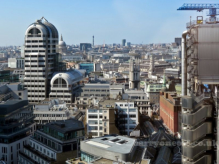





Docklands and the Thames,
Victoria Park to Paternoster
Square. Take a nostalgic
trip back to the East End in
the 1950’s or a stroll around
the Square Mile of the City
of London. It’s all here at
barryoneoff.co.uk
PEOPLE AND PLACES (3)
Copyright 2002 - 2024 ©Barry Carter. All rights reserved
Fredericks Place
This small cluster of buildings, just off of Old Jewry, are named after Sir John Frederick, who was a Lord Mayor of London in 1661. Most were designed by Robert Adam in the 1750's. Numbers 3,4,6,7 and 8 were grade II listed in the early1950's. They are owned by the The Worshipful Company of Mercers, first of the "Great Twelve" livery companies. Number 6 Fredericks Place is the third, and current, Mercers' Livery Hall. They moved here in May 1958. In the past, Fredericks Place has been home to Benjamin Disraeli, a British Prime Minister of the 19h. century. Also Edwin Waterhouse and Samuel Lowell Price, founders of Price Waterhouse, now Pricewaterhouse Coopers (PwC). There are blue plaques on the walls of the relevant buildings. Frederick’s Place is located within the Guildhall Conservation Area near Bank and St Paul’s Cathedral. Number 8 has been undergoing a 12 million pound refurbishment funded by The Mercers’ Company. Architects John Robertson have transformed 30,000 sq ft of space into modern offices, restaurant and coffee house scheduled for completion at around the time of this update (2020). The houses at numbers 2 and 6 have black painted metal arches in front of their entrances. On either side of the arches are two downward facing metal trumpet like fixtures. These were used by the coachman to snuff out his flaming torch after escorting the passengers from the carriage at night. Photo album here >>John Milton Plaque
The poet John Milton was born in Bread Street, which runs from Cheapside to Gresham Street. He was christened at All Hallows Church. Both the church, and his birthplace are no longer there due to rebuilding of the area. The plaque commemorating his birth was taken from the wall of All Hallows and now resides on the side wall of Saint Mary le Bow Church. There was also a bust of Milton in Bread Street but so far I have been unable to trace it’s whereabouts today. A new plaque commemorating the 400th. anniversary of his birth was erected in July 2008. He is buried in St. Giles Church, Cripplegate.The Garden at 120
Every new build in the City has to include in it’s planning a public space or park. Where is the best space-saving place to include it? On the roof of course! The Garden at 120 opened in February 2019 and is a fine example of this. An office block in Fenchurch Street with a well maintained open air garden on it’s roof accessible to everybody. Grab your lunch from a nearby supermarket and have a relaxing picnic on the roof. A height of 15 floors is not the tallest in London but still gives some stunning views. No booking is necessary at time of writing (2020), you are shown to the lift after a security scan and you make your way to the top. I made a visit shortly after the opening so the plant growth over the framework had not reached the desired level in my photos. See album >>The Walkie Talkie
The building at 20 Fenchurch Street was completed in 2014 and has been nicknamed the "Walkie Talkie" because of it's shape. Designed by Rafael Viñoly, it is 160 metres tall with 38 floors and a very large public area at the top, known as the "Sky Garden". There are bars and restaurants as well as views of the City. During construction it was found that the concave structure acted like a magnifying glass. At certain times of the day it directed the Sun's rays downward to the streets below. Temperatures were recorded up to 117 degrees Centigrade (243 Fahrenheit)! It melted the paint on parked cars and fried eggs held in it's path. It was dubbed the "Walkie-Scorchie" and "Fryscraper". Obviously the problem had to be solved by screening the glass at great expense. The rooftop Sky Garden is open to the public but your free slot must be booked in advance online.The Monument
The Monument to the Great Fire of London. Constructed from Portland stone. This memorial to the fire of 1666 was designed by Sir Christopher Wren and Robert Hook. At 202 high it was for many years the tallest structure in London. It also stands 202 feet away from where the fire started in Pudding Lane. You climb 311 winding stairs to reach the viewing gallery. The original idea for the column was for it to be a giant astronomical telescope but there was some trouble with the focal distance of the lenses and the idea was abandoned. A statue of King Charles II was to be placed on top but the King did not want the people reminded of the disasters during his reign and a bowl of golden flames was used instead. It was closed for a year for refurbishment and opened again in early 2009.The Brewery
If you walk down Chiswell Street from Moorgate you will find the “The Brewery”. Among the modern buildings there is an older brick construction on the corner of Milton Street. This was once a busy brewery operating out of the City. It was sold in September 2005. Before that it had been the site of Whitbread’s heritage since the company’s founder, Samuel Whitbread, started brewing there in 1750. Brewing ceased in 1976 although the site continued to be used as its head office until 2000. After that, it was turned into a conference and banqueting centre, still owned by Whitbread until the sale five years later to Earls Court & Olympia Group (ECO), owner of the west London exhibition centres. It remains a popular conference and events centre.






















